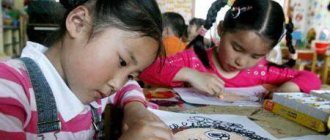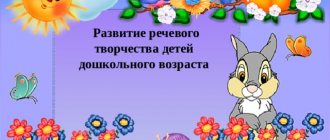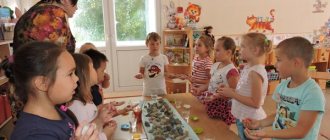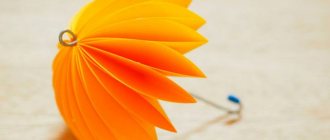Center for physical activity in kindergarten according to the Federal State Educational Standard
Organization of a physical activity center in kindergarten groups.
Independent motor activity of children is an excellent means of physical and emotional development of the individual.
Let us dwell in more detail on the characteristics of the conditions for the development of movements of preschoolers in different age groups. Junior preschool age A child of two or three years old is actively exploring the world, using for this a still small reserve of movements: crawling, climbing, climbing, throwing, rolling, etc. His movements are not yet coordinated, steps when walking and running are mincing and noisy, there is no coordination in the work of his arms and legs, and with sudden movements he often falls. But how many positive emotions does the little researcher receive from satisfying the need for movement given to him by nature? The first task of the teacher is to choose the right physical education and gaming equipment. It is necessary to proceed from what basic types of movements should be developed at this age: walking and running, balance and coordination, jumping on the spot (at two years) and jumping from a height (at three years); rolling, rolling and throwing the ball; crawling, crawling under arches, climbing into a box, onto a cube, climbing over a log, climbing a stepladder, etc. In this regard, for independent motor activity of children in a group room, it is advisable to have the following set of physical education equipment and small equipment: - smooth board (length 1.5 m, width 20 cm); — gymnastic bench (length 2 m, height 15 cm, width 20 cm); - ribbed board (length 1.5 m, width 20 cm); — two arcs for climbing and rolling balls (height 50 cm, width 50 cm); - two cubes (edge 25-30 cm); — drawers for climbing in (height 20.15 and 10 cm, width and length 50, 47 and 44 cm, respectively); — stepladder (height 1.5 m); - balls (diameter 6-8 cm, 10-15 cm, 20-25 cm) - five of each size; - one or two inflatable balls (diameter 40 cm); — rolling toys (two sets of different types); - log (length 1.5 m, diameter 20 cm); — recreational and preventive path (fine gravel, footprints, fabric of different textures, massage mats, etc.); — large toys on wheels (at least four); — cord (length 10 m, diameter 10-12 mm); - rattles, rings, plumes, ribbons, flags - according to the number of children; - four gymnastic sticks (length 75-80 cm); - gymnastic pole (length 1.8-2 m). Multifunctional modular sports and play equipment - a transformer - is optimal for the development of a child’s motor sphere. The “Cubes” manual is interesting and useful for the comprehensive development of movements. The equipment must be bright, attractive, meet hygienic requirements and safety rules. The teacher is obliged to check the stability and reliability of the equipment. This is especially true for swings, slides, and ladders, which are used only with an adult’s safety net. The second task is to correctly place physical education and gaming equipment. Often, educators, in an effort to zone the playroom, place equipment in a specific safe place (in a drawer, box, on a rack, etc.). We believe that this is not entirely advisable for the following reasons. Firstly, children's behavior is involuntary and situational. Comprehending the basics of movements, they study the properties of various objects and toys that fall into the area of their attention. For example, a child will be interested in a musical hammer until he notices a rotating inflatable ball mounted on the ceiling. Having accidentally stumbled upon a box with rings, the child will try to fit into it, and when he finds the details of the pyramid here, he will try to assemble the structure. Secondly, children aged two or three always imitate their peers. Therefore, when he sees how enthusiastically another child plays with a ball or fervently runs around the group room with a rolling toy, he will definitely want to follow his example. Physical education equipment for a child is the basis for learning how to use it. Place equipment and small inventory around the perimeter of the room in safe areas, modeling the trajectory and nature of the children’s movements. Try to ensure that the child does not have difficulty finding the item he needs. The object itself should stimulate and at the same time suggest a way to perform actions with it or on it. Creating game situations (“a bear sitting on a gurney”, “a kitten stuck on the top rung of a stepladder”, “a car located under an arc-garage”, “a bunny sitting on a ribbed board”) will be a powerful incentive to repeatedly perform motor skills. actions with toys. Of course, there is no need to turn your playroom into an equipment storage area. However, it is important that the inventory fits logically into the interior of the room, and change its location once or twice a week, combining several items into a single obstacle course. Thus, in the first and second junior groups it is not advisable to create a special physical education corner. The entire room should be a single movement space in which each child can satisfy his need for movement, acting with a variety of physical education and play aids. Middle preschool age According to research, in the fifth year of life, preschoolers experience a significant increase in motor activity indicators. The child becomes more mobile and seems tireless. However, its capabilities are still small. He is poorly oriented in space and is not dexterous enough, so careful control over the intensity and content of his independent motor activity is necessary. Since physical education classes in the middle group are held in the gym, there is no need to keep all the equipment in the group room. We recommend setting up a special physical education corner for children to practice independently. The optimal place for such activities is an area away from windows, closets, and a corner of wildlife. Niches, shelves, hooks, drawers, carts and other options for placing equipment must meet hygienic and pedagogical requirements, and the equipment itself must meet the principle of expediency. For example, the Darts game should be placed at the child’s eye level, foot massagers should be placed in a niche on the floor, etc. The physical education corner should logically fit into the interior of the room, harmonizing with it in color and style. When selecting physical education equipment, it is also necessary to take into account the possibility of organizing the physical activity of children in a limited area individually and in small groups. It is advisable to place equipment that will help consolidate the motor skills acquired by children in classes. However, some of the equipment (ladders, arches, benches, etc.) are too cumbersome, and the use of other aids (gymnastic sticks, balls) is unsafe without the supervision of a teacher. It is advisable to place such equipment on the site and use it during a walk. Physical education and gaming equipment specially designed for a group room is universal - small-sized, lightweight, with a pronounced entertainment and developmental focus: - skittles (one or two sets); — game “Darts” (with Velcro balls); — rackets with balls with Velcro; — floor and hanging ring throwers; — game “Towns” (made of plastic); - foam and fabric balls; - two or three jump ropes, a cord; — plumes, ribbons, flags, plastic dumbbells (two or three sets); - two or three bags weighing 200 g; - two or three hoops; - tambourine, musical hammer; — health and preventive path (fine gravel, footprints, fabric and materials of different textures, massage mats, etc.). If in younger groups children learned the basics of movements and explored the possibilities of using each object, now they strive to perform movements in different ways, choosing the most rational one. In other words, children begin to master the correct technique of movements. Senior and preparatory preschool age A higher level of psychophysical development of a senior preschooler ensures corresponding changes in his motor activity: coordination of movements improves, motor actions become more economical, coordinated and rhythmic. Thanks to a fairly high level of orientation in space and volitional regulation, the child behaves confidently in a limited space, can slow down movement, change its direction, switch to another, which makes his activities in a group room safer. The accumulated motor experience allows children to spend their free time meaningfully, organize games with peers, and independently use a variety of equipment. In older preschool age, the child’s psychophysical qualities and motor abilities develop: speed (5 years), strength and flexibility (5-6 years), endurance (6 years), eye and coordination of movements (6.5 years). In addition, there is a difference in interests and preferences among children of different sexes. Preschoolers gravitate towards complexly coordinated motor actions and sports games, and training devices that allow them to perform a variety of movements, so the physical education corner in older groups has its own characteristics. Firstly, the corner becomes a “mirror”, which reflects the sports life of the group (competitions, family tourist gathering, etc.). For example, after a physical education festival or an Olympics, you can place a pennant, cup, and photographs of participants in a corner; after a tourist walk - children’s drawings reflecting their impressions, as well as crafts made from natural materials. Here you can also place thematic mini-collections of badges, stamps, postcards, talismans; Place board sports games (basketball, hockey, checkers, etc.) in a specially designated place (niche, folding table). Secondly, the contents of the physical education corner are replenished with sports equipment, with the help of which elements of sports games are taught. Thirdly, the simplest small-sized training devices are added to the corner. They can be replaced by homemade rubber expanders for strength exercises, elastic bands for jumping, balance beams for developing balance, etc. Fourthly, an option for equipping a corner can be a ready-made mini-stadium or a physical training complex. The apparatuses are arranged in the form of a “gymnastic tree” so that from one apparatus one can climb onto two adjacent ones. The following movements are basic for various combinations on apparatus: hanging (crossbar, rings and trapezes), jumping, rotation (waist looping), swinging (removable rocking bag, swing and vertical swing vines), rolling (indoor slide), balance ( inclined triangular ladder) and climbing (all of the above equipment). A trampoline is stretched under all the equipment or a mat is placed, which both insures and provides shock absorption during a dismount. In order for the mini-stadium to be popular, classes can be given a plot-like character. It is known that children are most attracted to performing entertaining exercises in accordance with the accepted role. They happily imitate the habits of a cat, squirrel, or monkey climbing from branch to branch. By joining in the plot proposed by the teacher or inspired by a fairy tale or cartoon, children gladly respond to the offer to climb to the top of a tree, stock up on nuts, get bananas from the top branch, etc. Shells can be decorated and diversified with homemade attributes. This will keep children interested in doing gymnastic exercises. Organizing independent classes at such a mini-stadium is possible subject to the following conditions: periodic testing of structures for strength and stability of fastenings; teaching children safe techniques for performing exercises, how to climb from apparatus to apparatus; strengthening the self-insurance technique; performing exercises in sports shoes or barefoot; provision of insurance by the teacher. Indicative list of equipment for a standard physical education corner: - game “Towns” (made of plastic); — rackets and ping-pong balls (two sets); - skittles (one or two sets); — a small basketball hoop and fabric balls; — game “Darts” (with Velcro balls); - ring throw; - one or two rubber expanders; — two “Health” disks; — mini treadmill; — track roller; - two or three jump ropes and elastic bands; - plumes, ribbons, braids; - tambourine; - two or three hoops; — board sports games; — simulators (foot, hand); — massagers (foot, hand). Older preschoolers prefer same-sex company and, accordingly, certain types of movements. Boys are more attracted to exercises aimed at developing strength, speed, agility, and accuracy; girls - to develop coordination, plasticity, flexibility, expressiveness of movements. Increasing the independent motor activity of children is considered as one of the effective means of preserving the child’s health, improving his physical fitness, enriching his motor experience, and increasing his creative and cognitive potential. References 1. Vavilova E.N. Develop agility, strength, and endurance in preschoolers. - M.: Education, 1981. 2. Glazyrina L.D. Physical education - for preschoolers. - M.: Vlados, 1999. 3. Gromova S. Subject-based physical education classes with elements of corrective gymnastics // Preschool education. - 1996.- No. 6, 8, 10. 4. Erofeeva T.I. Modern educational programs for preschool institutions. – M., 1999. 5. Lazarev M.L. Hello! Educational and methodological manual for teachers of preschool educational institutions. - M.: Mnemosyne, 2004. - 248 p. 6. Makhaneva M.D. Raising a healthy child. - M., 2000. 7. Fundamentals of safety for preschool children / Ed. V.A.Ananyeva. - M.: Academy, 2000. 8. Osokina T.I. Physical education in kindergarten. - M.: Education, 1986. 9. Runova M.A. Motor activity of a child in kindergarten: A manual for preschool teachers, teachers and students. - M.: Mozaika-Sintez, 2004. - 256 p. 10. Stasyuk A.M., Zhuravleva N.A. About the system of physical culture and health work // Preschool education. – 1997. – No. 9. — P.39-42. 11. Sukharev A.G. Health and physical education of children and adolescents. - M.: Medicine, 1991. - 272 p. 12. Fedorovskaya O.M. Physical education, health and preventive work in preschool educational institutions // Preschool education. – 2004. – No. 1. – P. 33-36. 13. Khukhlaeva D.V. Methods of physical education in preschool institutions. - M.: Education, 1984. 14. Khukhlaeva D.V. Theory and methods of physical development of preschool children. – M.: Education, 1976. 15. Shebeko V.N. Physical education of preschool children. – M.: Academy, 1996
We recommend watching:
Program for kindergarten in physical education of a preschool educational institution, Junior - middle group Work program for physical education in a preschool educational institution, taking into account the Federal State Educational Standard. Senior - preparatory group Organization of physical activity of children during a walk in a preschool educational institution Independent motor activity in kindergarten
Similar articles:
The role of folklore in the physical education of preschool children
Morning exercises in the second junior group in a playful way
Morning exercises in kindergarten in the preparatory group
Work experience "Sports club in a preschool institution"
Nadezhda Sukhova
Work experience "Sports club in a preschool institution"
Annotation. This material is aimed at describing the work in a preschool institution of a club for the interests of physical culture and sports with a focus on “ Sports ,” which helps to increase physical activity and the harmonious physical development of preschoolers from 3 to 7 years old .
Everyone knows that through movements a child learns about the world, his mental processes, will, independence, discipline, and collectivism develop. The formation of a healthy, strong, cheerful, enterprising child who has good control over his movements and loves sports and physical exercise is important for the all-round development of a preschooler . The more varied the movements, the more information enters the brain, the more intense the intellectual development.
In the kindergarten there is a sports club with a physical education and sports orientation .
The goal of the club is to create conditions for physical fitness and physical activity of preschool children .
Club objectives :
— formation of sustainable interest in sports activities of a gaming and non-game nature;
— development of initiative, independence, creativity in motor activity, the ability to self-control, self-esteem when performing movements;
— satisfying children’s natural need for movement in various forms of physical education and sports activities ;
— development of physical qualities: strength, speed, endurance, agility;
- development of interest in participation in outdoor and sports games and physical exercises, activity in independent motor activities, interest and love for sports , and a healthy lifestyle.
In the kindergarten, an environment is organized in which the activities of the sports club . The large gym is equipped with modern physical education and sports equipment for the physical development and preparedness of children.
To prevent posture, flat feet and develop general motor skills, corrective paths, massage mats, flat tracks with palms , and balance beams are used.
For children's fitness classes - fitballs, step platforms, health discs, gymnastic rollers. A, for the development of basic types of movements (jumping, throwing, climbing)
— there are wooden cubes, trampolines, jump ropes, bags with weights, medicine balls, throwing targets, ring throws, balls of different sizes, a set of soft modules, a gymnastic ladder, a climbing wall, gymnastic mats, a gymnastic complex.
For teaching preschoolers elements of sports games (football, basketball, tennis)
In the kindergarten there are soccer balls and mini goals, a tennis table, rackets and balls, basketball stands and balls.
In addition, the gym has children's exercise equipment that satisfies the needs of children in movement, influencing individual muscle groups, such as: “Twister”, “Stepper”, “ Rowing”
,
“Rider”
“Running”
exercise machine along the waves” , a strength trainer, and an educational interactive floor with a set of standard educational games.
All equipment is accessible to children and contributes to the effective organization of the pedagogical process of the sports club , creates favorable conditions for joyful, meaningful activities in collective ( sports and outdoor )
games and entertainment.
Coming to the club , preschoolers learn to interact with each other, develop physical qualities, motor skills and abilities.
Family health club in the preparatory group of a kindergarten. Work plan
FAMILY HEALTH CLUB "HEALTHY FAMILY" in a preschool educational institution
author: Natalia Valerievna Radygina, teacher of the Madou - kindergarten No. 5 "Rodnichok", Tchaikovsky, Perm Territory Description of the material: I bring to your attention a plan for a family club to promote a healthy lifestyle
Regulations on family health club "Healthy Family"
Duration of the club's activity:
1 year
Members of the club:
children of the preparatory group, head of physical education, educators, parents, (legal representatives of pupils)
Rights and obligations of the parties
The activities of the Club are carried out on a voluntary basis.
The preschool educational institution provides premises for Club meetings. Club members have the right to give recommendations and make proposals. Organization of the club's work:
The work of the Club is organized taking into account the age of the children.
Club meetings are held at least once a month and as needed. The Club’s decisions for employees and parents are advisory in nature. Goal:
Promoting a healthy lifestyle.
Create a continuous system of health-improving work in preschool educational institutions and families. Objectives:
1. To involve parents in participating in the life of preschool educational institutions by searching for and implementing the most effective forms of work.
2. Expand parents’ knowledge about the physical education and health work of preschool educational institutions. 3. Actively include parents in the process of physical education of children. Expected results: Parents' responsibility for the health of their children has increased: organizing a physical corner at home, joint sporting events.
Mastered self-healing skills: hardening at home, doing gymnastics at home, buying sports equipment. The activity of parents in organizing family leisure aimed at improving and preserving the health of children has increased: family outings on skiing, ice skating, swimming in reservoirs in the summer. Reducing morbidity in children. teachers spoke at the final ped. advice with experience. Work plan of the family health club “Healthy Family”
October:
1. Questionnaire “Physical education in the family.”
Task: to analyze for further work how health-improving activities are carried out in the family. Study the parents' request. 2. Enrichment of the development environment. Task: To involve parents in creating a developmental environment November:
1. Conduct exercises by the parent.
Objective: To create emotional comfort and harmonious relationships between children and adults. 2. Attending a physical education lesson at school 3. Task: Interact with the school. December:
1. Conducting exercises by the parent Task: Create emotional comfort, harmonious relationships between children and adults.
2. Exchange of experience at a parent meeting. 3. Family outing to the skating rink. Objective: To introduce family sports activities into the practice of parents. January:
1. Family snow tubing on Snezhinka.
Objective: Joint leisure time for children and parents to strengthen and preserve the health of preschoolers. February:
1. Conducting exercises by the parent.
Task: Continue to create harmonious relationships in the family. 2. Physical education “Together with my dad, I am a hero” Objective: To involve dads in cooperation in creating a healthy lifestyle for their children. March:
1. Meeting with interesting people “Athletes of our city” (watching programs about sports, meeting with the editor-in-chief of the sports newspaper “BDG” Eremeeva) Objective: To cultivate pride in our city, introduce children to modern athletes of our city.
April:
1. Conducting exercises by the parent.
Task: Introduce exercise into family traditions. 2. Physical education leisure “Outdoor games that our parents played in childhood” Objective: To create conditions for interaction between families. May:
1. Organization of exercises for children in the preparatory group. Task: Interaction with kids. Development of organizational and sports abilities of children.
We recommend watching:
Modern forms of work with parents on music education Work with parents in additional education of children Lesson notes in the preparatory group of a preschool educational institution. Kind word Summary of experimental research activities in the preparatory group
Similar articles:
Summary of the walk in the preparatory group “Water Observation”
Summary of the walk in the preparatory group “Observation of snow and ice”
Walks in the preparatory group. Card file with goals for May
Epics for preschool children
Assignments on the topic “Forest” for children 6-8 years old





